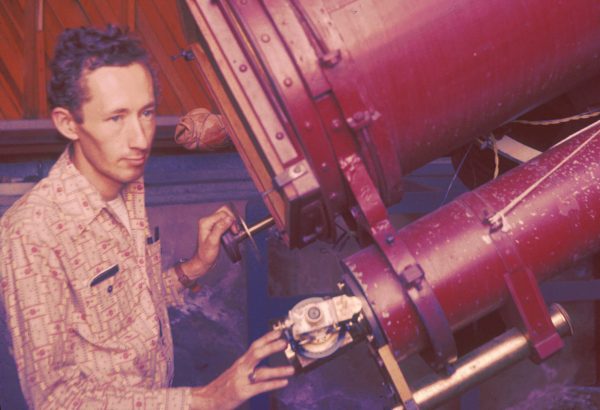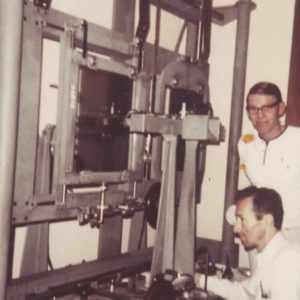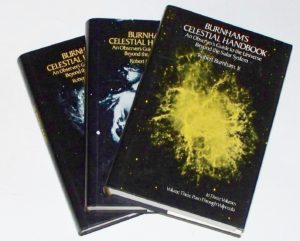
Robert Burnham, Jr. at Lowell Observatory's Lawrence Lowell Telescope while he worked on the observatory's Proper Motion Survey. This is the same telescope that Clyde Tombaugh previously used to discover Pluto.
The appeal of astronomy is both intellectual and aesthetic; it combines the thrill of exploration and discovery, the fun of sight-seeing, and the sheer pleasure of firsthand acquaintance with incredibly wonderful and beautiful things…
So wrote longtime Flagstaff resident Robert Burnham, Jr., the author of one of the most prized astronomy books of our time. Burnham’s story is one of passion, persistence, and, ultimately, tragedy.
Robert Burnham, Jr. was born in Chicago on June 16, 1931. His family moved to Arizona in 1940, settling in Prescott. At an early age Robert began a lifelong pursuit of studying the universe, collecting rare coins, amassing bookshelves full of rocks and minerals, and peering at the sky through telescopes—all while reading as much as he could on each subject.
He graduated from Prescott High School in 1949 and two years later enlisted in the Air Force. After his four-year-tour finished, he returned home to Prescott and eventually took a job as a shipping clerk, though he continued his passion of studying the universe. It was at about this time that he began thinking about compiling an astronomy book like no other, one that comprehensively covered the science and mythology of all 88 constellations.
And so went Burnham’s life for several years—uninspiring job during the day, probing the depths of nature from Earth to outer space at night. And then one night in 1957 his life took a decided turn when he spotted a fuzzy patch of light through his telescope. This was a comet, and up to this day no one else had ever seen it before. He was not alone in detecting it, as two other observers independently discovered this new celestial nomad. News traveled fast and Burnham soon became a celebrity of sorts, lauded as the self-trained amateur astronomer from Prescott. None other than Senator Barry Goldwater visited Burnham and even gave the young man a family telescope that dated back to the 1800s.
Burnham Joins Lowell’s Proper Motion Survey Team
Not long after, Burnham found himself in conversation with Astronomer Henry Giclas of Lowell Observatory. Giclas had begun a program to study the movement of stars over time, a so-called proper motion survey, and hired Burnham to work on it. Soon he also moved into a cabin onsite.

Robert Burnham, Jr. and Norm Thomas at the blink comparator they used for Lowell’s Proper Motion Survey, December 1964.
Burnham would spend the next 21 years living in that same cabin at Lowell Observatory, a short stroll from telescopes he could only dream of as a kid. No longer would he have to spend many of his waking hours at a hum drum job; he could now devote virtually all his waking hours to studying the universe. When not fulfilling his regular job duties of photographing the night sky and examining the resulting images, he jumped headfirst into his long-planned “Celestial Handbook”.
With the patience of Job, Burnham marched through the constellations and self-published his magnum opus in loose-leaf folders that the kids of Lowell staffers helped assemble. Eventually, with the vision of substantial royalty payments in mind, Burnham sold the rights to Dover. Little did he know that his life had reached its apex and soon would begin to spiral downward..
Life After Lowell
The proper motion survey ended in 1979 and Burnham was out of a job. After 21 years, he no longer enjoyed regular access to research telescopes, no longer had a home, no longer had a regular income. To many people this would have been a challenge but one they could conquer. To Burnham, this was almost a death sentence. As eloquent as Burnham was on paper, he was equally awkward in person. Exceptionally introverted—former Lowell Observatory Director Bob Millis calls Burnham the most shy person he ever met—Burnham was not one to go out into the world and start over. Without the regularity of his beloved work and the stability of his adopted lifetsyle–as well as an apparent psychosis that would plague him for the rest of his life–he was lost.
Burnham lived with his sister for a short time and then disappeared, with neither family nor friends knowing his whereabouts. A few years later, the son of one of Burnham’s closest Lowell colleagues was walking through Balboa Park in San Diego when he noticed a skinny, bearded man. As he drew near, he realized the man was Burnham. He learned that Burnham lived in bleak housing nearby, having never seen the riches he expected from the handbook royalties and making a minimal living by selling paintings of cats in the park.
In 1993, at the age of 61 and after suffering from a heart attack and other health maladies, Burnham died. His remains went to Fort Rosecrans National Cemetery’s columbarium in San Diego. Burnham was a loner to the end: his name was misspelled on his grave marker and his family didn’t even find out he died until two years later.

Burnham’s Celestial Handbook is a staple in the library of astronomy enthusiasts around the world.
Celebrating Robert Burnham, Jr.
While Burnham’s tragic life ended in obscurity, his beloved handbook lives on and is a staple in the library of thousands of astronomers, professional and amateur alike. Burnham chronicler Tony Ortega has called Burnham’s 2138-page handbook a real-life Hitchhiker’s Guide – “part travel guide, part history text, part encyclopedia, it’s like a handheld natural-history museum of the universe.”
In recent years, efforts have been made to honor Robert Burnham. Amateur astronomers in Phoenix led an effort to create a plaque honoring Burnham, and Lowell Observatory is now developing a new display highlighting his life and work.
Next week, as part of National Astronomy Day, Lowell Observatory is hosting a virtual discussion about the triumph and tragedy of Burnham. Ortega, Burnham’s niece Donna Courtney, and renowned sky expert Brian Skiff of Lowell will participate and take questions from the virtual audience. The event begins at 6:30 pm on September 26, via Lowell Observatory’s YouTube page.